What does ADAS mean on a car?
ADAS stands for Advanced Driving Assistance System and can be identified as any driver aid that helps with positioning of the car whilst driving and identifying potential hazards. It can perform corrective steering and activate brakes (active type ADAS system) and or give warnings via audible and visual means (passive type ADAS system) when a potential hazards are recognised by the array of sensors and cameras then take action accordingly. It can identify road signs, monitor blind spots, maintain vehicle position relative to traffic and road position and even take preventative measures to avoid collisions (autonomy). ADAS systems fitted to each vehicle vary by manufacturer, name and car specific options
We utilise the latest technology and calibrate ADAS cameras and radars with high definition cameras for totally accurate positioning of targets, meaning perfect calibration every time and no human error. All calibrations supplied with a certificate of conformity and diagnostic report.
ADAS can not be calibrated without calibrated equipment and certification and importantly our technicians are IMI trained and accredited so all ADAS calibrations are carried out to the BS:10125 standard.
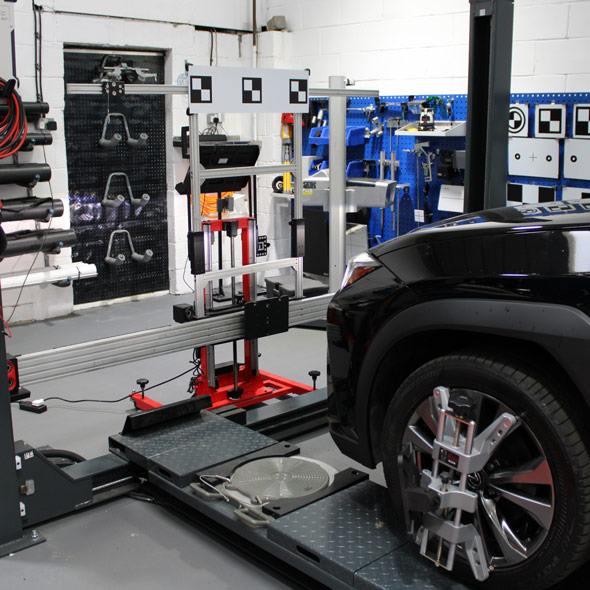
Photo: ADAS Calibration lane assist
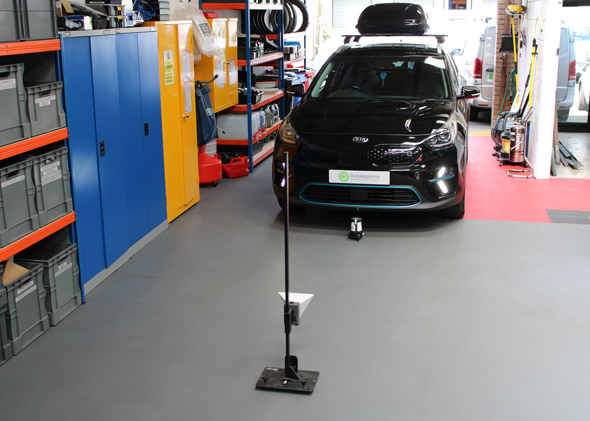
Photo: ADAS Calibration front radar
Reasons for ADAS calibration
If the ADAS emergency braking/ACC is not calibrated correctly it can potentially cause a collision, if the vehicle doesnt recognise an object or even identifys an object that isnt there it can slam on the brakes with no notice. The lane assist if not calibrated correctly can affect the autonomous steering and may react to false positives causing the vehicle to unexpectively change lane, putting you in greater danger, completely against the intention of the device. All ADAS systems are integrated into other vehicle systems so a failure of an ADAS component can lead to other problems.
Apart from the obvious warning lights illuminated on the dash display advising service of ADAS systems there are also many other reasons for ADAS calibration. Manufacturer guidelines depending on vehicle specify that following repairs on suspension, replacement of windscreen, wheel alignment and following an accident/repair certain systems need recalibration.
For example if the ADAS emergency braking/ACC is not calibrated correctly it has potential to cause a collision, if the vehicle does not recognise an object in its path, or even thinks an object is there that isn't it could slam on the brakes with no notice. The lane assist if not calibrated correctly can affect the autonomous steering and may react to false positives causing the vehicle to unexpectedly change lane, putting you in greater danger, completely against the intention of the device. All ADAS systems are integrated into other vehicle systems so a failure of an ADAS component can lead to other problems.
Dynamic vs Static ADAS calibration
ADAS calibration can be carried out by two different methods or a combination of both which varys according to manufacturer and vehicle model. Static calibration is performed by location of specifically designed target boards in front of the ADAS camera or radar then the ADAS system is put in calibration mode which will identify the location of the target in space to the predetermined measurements. Our ADAS calibration system uses high definition cameras for accurate placement of targets.
Dynamic calibration is carried out by activating the calibration mode of the ADAS system requiring calibration then performing a specified test drive for the system to recognise its position in space then adjustment as necessary.
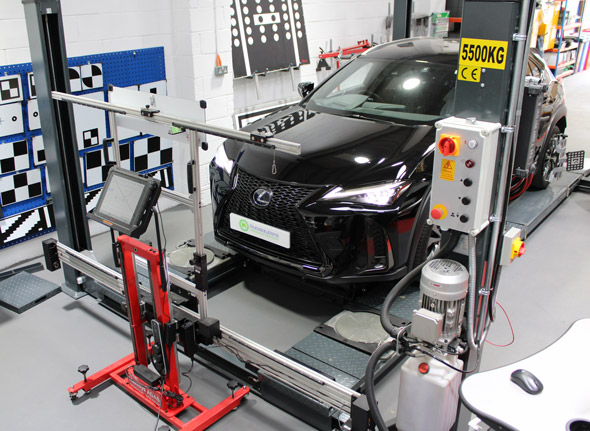
Photo: ADAS Calibration lane assist
ADAS systems include
- ADAPTIVE CRUISE CONTROL (ACC)
Adjusts vehicle speed to maintain gap to vehicle in front and can perform emergency braking
- AROUND VIEW MONITORING (AVM)
Provides 360 birdseye view around vehicle for parking and manouvering in tight spaces
- BLIND SPOT DETECTION (BSD)
Monitors driver side and passenger side areas not covered by mirrors or visually from the drivers seat
- DRIVER STATE MONITORING (DSA)
Monitors driver inputs such as sharp steering maneuvers and warns driver to take a break
- FRONT CROSS TRAFFIC ASSIST (FCTA)
Utilises radars or cameras in extreme front positions to monitor at right angles approaching bikes and cars when vehicle starts to cross a junction
- LANE DEPARTURE WARNING (LDW)
Maintains vehicle position driving between the white lines or warns driver when exiting white lines
- LIGHT IMAGING DETECTION AND RANGING (LIDAR)
Creates a 3D image of obstacles and background close to medium range
- NIGHT VISION (NV)
Front camera creates an image in infra red being more affective at night or in fog
- PARK DISTANCE CONTROL (PDC)
Uses a series of sensors that produce ultrasonic pulses to identify objects at close range
- REAR CROSS TRAFIC ASSIST (RCTA)
When selecting reverse monitors in extreme rear positions at right angles bikes and cars aproaching as vehicle moves out of a parking space
- REAR VIEW CAMERA (RVC)
When selecting reverse constructs image to help with parking and identify objects in the vehicles path
All of these systems can work passively or actively by either warning the driver or actuating driving controls depending on settings and option fitted to vehicle.
PLEASE DO NOT USE THESE SYSTEMS AS A SUBSTITUTE FOR SAFE DRIVING PRACTISE
Note: Vehicle manufacturers may vary acronyms and names for there own trademark systems
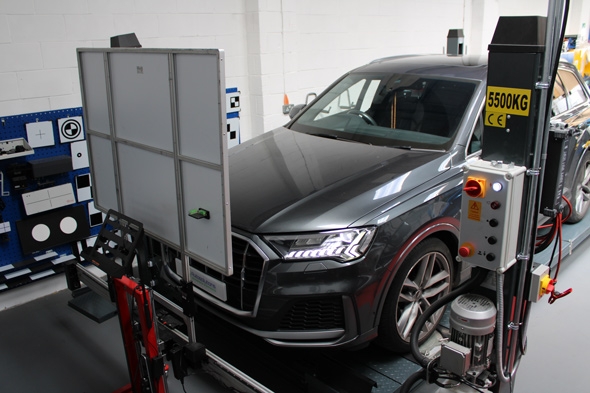
Photo: ADAS Calibration front lane assist
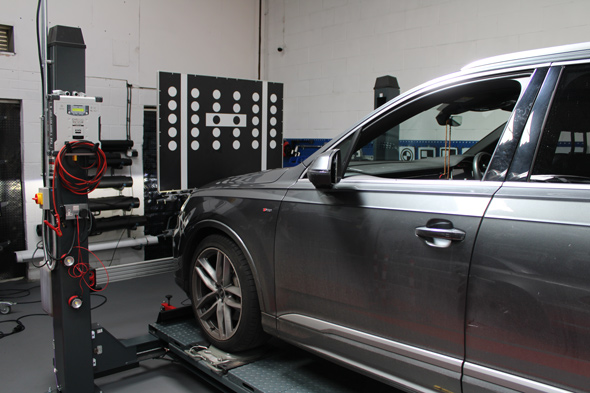
Photo: ADAS Calibration lane assist type 3
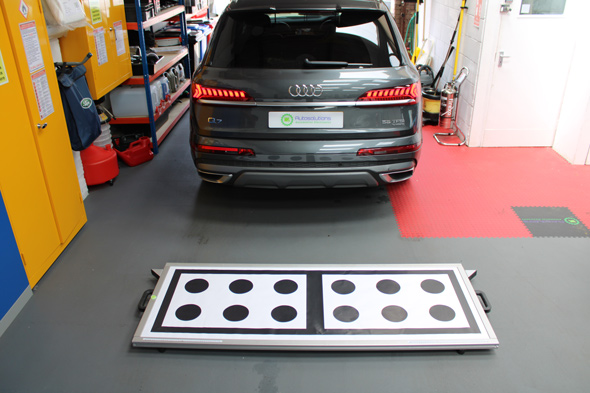
Photo: ADAS Calibration rear parking camera
Contact our specialist EV garage to book an appointment for your electric car repair: Call 020 8189 9778, or email us at enquiries@autosolutions-ae.co.uk.
All customers have access to our free Wifi, plug sockets/phone chargers, electric vehicle charge point and refreshments.